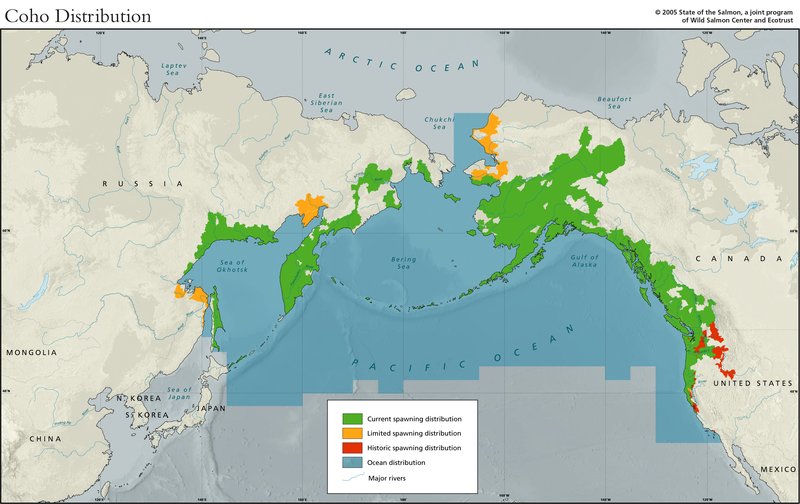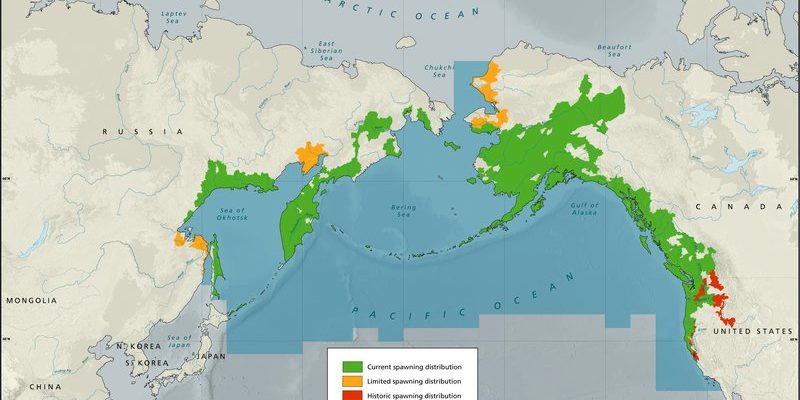
These remarkable fish are more than just pretty faces in the water. They have a life cycle that takes them from ocean depths to freshwater rivers, and understanding their habitats is crucial to appreciating their incredible journey. So, grab a cup of coffee, and let’s explore where salmon live, their habitats, and the challenges they face along the way.
The Different Types of Salmon
There are several species of salmon, and knowing their differences can help us understand where they live. Here’s a quick overview of the main types:
- Chinook Salmon: Also known as king salmon, these are the largest species. They live in the Pacific Ocean and migrate to rivers in the U.S. and Canada.
- Coho Salmon: Known as silver salmon, these fish are smaller than Chinooks. They inhabit coastal waters and rivers, mainly in North America.
- Pink Salmon: The smallest of the five species, pinks are found in the Pacific Ocean, predominantly around Alaska.
- Sockeye Salmon: These are known for their bright red color and are found in both freshwater and saltwater, especially in Alaska and parts of Canada.
- Atlantic Salmon: Unlike their Pacific counterparts, Atlantic salmon mainly inhabit the North Atlantic and are often farmed for food.
Each of these types has its preferred habitats, so understanding these nuances is key to grasping where you might find them.
Freshwater vs. Saltwater: Where Do They Thrive?
Salmon are unique in that they live in both freshwater and saltwater environments throughout their lives. In the early stages, they hatch in freshwater rivers and streams. Once they mature, they migrate to the ocean, where they spend several years feeding and growing.
Here’s how it works:
– Hatching and Early Life: Salmon eggs are laid in freshwater streams or rivers, where they hatch into fry. They need clean, cold, oxygen-rich water to survive at this stage. Think of it like a secure nursery where the baby salmon can grow and learn to swim.
– Migration to the Ocean: After spending some time in freshwater, young salmon, called smolts, begin their journey to the ocean. This migration is like moving to a bustling city. They adapt to new saltwater conditions, finding plenty of food and space to grow.
– Return to Freshwater: Once they reach maturity after several years in the ocean, adult salmon make the incredible journey back to their birthplace to spawn. This is a remarkable feat since some species travel hundreds of miles upstream against strong currents!
Key Salmon Habitats
Salmon thrive in specific habitats that provide the right conditions for their life cycles. Here are some key areas:
Rivers and Streams
Rivers and streams are crucial for spawning salmon. The right conditions—cold, clean water with gravel beds—are essential for egg-laying. Look for:
– Fast-flowing waters: These streams provide oxygen-rich environments that help young salmon thrive.
– Gravel beds: Salmon prefer to lay their eggs in gravel, which protects them from predators and provides a suitable environment for hatching.
Estuaries
Estuaries are where freshwater from rivers meets the salty ocean. These areas are rich in nutrients and serve as a critical stop for juvenile salmon. Why are they important?
– Feeding Grounds: Estuaries are filled with food sources like plankton and small fish, allowing young salmon to grow before heading to the ocean.
– Shelter: The brackish water provides a safe transition for salmon adapting from freshwater to saltwater.
Oceans
Once salmon make it to the ocean, they can be found in various marine environments. Here are some notable spots:
– Nearshore Waters: Adult salmon usually stay close to the coast, where they find food-rich habitats.
– Open Ocean: As they grow, some salmon venture deeper into the ocean, exploring different depths and areas.
Geographical Distribution of Salmon
Salmon are most commonly found in the northern hemisphere. Their distribution can be broken down as follows:
- Pacific Salmon: Found primarily in the Pacific Ocean, along the coasts of North America and Asia.
- Atlantic Salmon: Located in the North Atlantic, these salmon are found along the coasts of Europe and North America.
It’s fascinating to see how the geographical distribution affects their habitats. Each species has adapted to specific regional climates and ecosystems.
Challenges Salmon Face in Their Habitats
Salmon face numerous threats in their habitats today. Understanding these challenges can help us appreciate the need for conservation efforts. Some key issues include:
– Pollution: Contaminants from urban areas and agricultural runoffs significantly impact water quality in rivers and streams, harming salmon eggs and fry.
– Overfishing: Unsustainable fishing practices can deplete salmon populations, leading to a decline in numbers. When you think about it, it’s like crowding a small restaurant with too many customers—everyone ends up dissatisfied.
– Habitat Loss: Development along riverbanks and coastal areas often destroys the natural habitats salmon need to spawn and grow. This is like building a city block over a vital park; it reduces space and resources for wildlife.
Conservation Efforts
Fortunately, many organizations and communities are taking steps to protect salmon habitats. Here are some initiatives making a difference:
– Habitat Restoration: Efforts focus on restoring riverbanks, removing barriers like dams, and improving water quality to provide better conditions for salmon.
– Sustainable Fishing Practices: Regulations and awareness campaigns promote responsible fishing to ensure salmon populations remain healthy.
– Education and Awareness: Teaching the public about salmon and their habitats encourages support for conservation efforts. When people understand the importance of these fish, they’re more likely to get involved.
The Importance of Salmon in Ecosystems
Salmon play a critical role in their ecosystems. They contribute to the health of both freshwater and marine environments. Here’s why they matter:
– Nutrient Cycling: When salmon spawn and die, their bodies provide essential nutrients to the ecosystems they inhabit, supporting various plant and animal life.
– Food Source: Salmon are vital for numerous predators, including bears, birds, and even humans. Their presence supports various food webs, making them integral to ecosystem health.
Understanding where salmon live and why they matter underscores the importance of protecting their habitats. As we face environmental challenges, knowing these details is more crucial than ever.
Closing thoughts: Salmon are impressive, resilient creatures that navigate complex lives across diverse habitats. Their journey—from freshwater streams to the vast ocean and back—serves as a reminder of nature’s interconnectedness. Protecting their homes and ensuring their survival is not just important for the fish but for our planet’s health as a whole. So next time you see salmon on your plate or a documentary featuring them, remember the remarkable world they inhabit.

